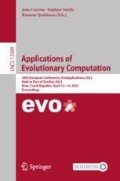Abstract
The robust and reliable prediction of urban traffic provides a pathway to reducing pollution, increasing road safety and minimising infrastructure costs. The data driven modelling of vehicle flow through major cities is an inherently complex task, given the intricate topology of real life road networks, the dynamic nature of urban traffic, often disrupted by construction work and large-scale social events, and the various failures of sensing equipment, leading to discontinuous and noisy readings. It thus becomes necessary to look beyond traditional optimisation approaches and consider evolutionary methods, such as Genetic Programming (GP). We investigate the quality of GP traffic models, under both normal and anomalous conditions (such as major sporting events), at two levels: spatial, where we enhance standard GP with Transfer Learning (TL) and diversity control in order to learn traffic patterns from areas neighbouring the one where a prediction is needed, and temporal. In the latter case, we propose two implementations of GP with TL: one that employs a lag operator to skip over a configurable number of anomalous traffic readings during training and one that leverages Vectorial GP, particularly its linear algebra operators, to smooth out the effect of anomalous data samples on model prediction quality. A thorough experimental investigation conducted on central Birmingham traffic readings collected before and during the 2022 Commonwealth Games demonstrates our models’ usefulness in a variety of real-life scenarios.
This work is supported by the Engineering and Physical Sciences Research Council (Grant Number EP/R512989/1).
Access this chapter
Tax calculation will be finalised at checkout
Purchases are for personal use only
Notes
- 1.
Available at https://sdgs.un.org/goals, in particular, goal 11, action 11.2.
- 2.
- 3.
- 4.
Such as Darmstadt: https://www.ui.city/en/.
References
Almeida, A., Brás, S., Oliveira, I., Sargento, S.: Vehicular traffic flow prediction using deployed traffic counters in a city. Futur. Gener. Comput. Syst. 128, 429–442 (2022)
Azzali, I., Vanneschi, L., Bakurov, I., Silva, S., Ivaldi, M., Giacobini, M.: Towards the use of vector based GP to predict physiological time series. Appl. Soft Comput. 89, 106097 (2020)
Bliemer, M.C., Ban, X.J., Leclercq, L., Qian, S., Unnikrishnan, A., Yang, X.S.: Special issue on dynamic transportation network modelling, emerging technologies, data analytics and methodology innovations. Transport. Res. Part C: Emerg. Technol. 142, 103778 (2022)
Boukerche, A., Tao, Y., Sun, P.: Artificial intelligence-based vehicular traffic flow prediction methods for supporting intelligent transportation systems. Comput. Netw. 182, 107484 (2020)
Cacco, A., Iacca, G.: Simulation-driven multi-objective evolution for traffic light optimization. In: Castillo, P.A., Jiménez Laredo, J.L., Fernández de Vega, F. (eds.) EvoApplications 2020. LNCS, vol. 12104, pp. 100–116. Springer, Cham (2020). https://doi.org/10.1007/978-3-030-43722-0_7
Cintrano, C., Toutouh, J.: Multiobjective electric vehicle charging station locations in a city scale area: malaga study case. In: Jiménez Laredo, J.L., Hidalgo, J.I., Babaagba, K.O. (eds.) EvoApplications 2022. LNCS, vol. 13224, pp. 584–600. Springer, Cham (2022). https://doi.org/10.1007/978-3-031-02462-7_37
Ekárt, A., Patelli, A., Lush, V., Ilie-Zudor, E.: GP with transfer learning for urban traffic modelling and prediction. In: 2020 IEEE CEC, pp. 1–8 (2020)
Kajihara, S., Sato, H., Takadama, K.: Generating duplex routes for robust bus transport network by improved multi-objective evolutionary algorithm based on decomposition. In: Castillo, P.A., Jiménez Laredo, J.L. (eds.) EvoApplications 2021. LNCS, vol. 12694, pp. 65–80. Springer, Cham (2021). https://doi.org/10.1007/978-3-030-72699-7_5
Li, J., Guo, F., Sivakumar, A., Dong, Y., Krishnan, R.: Transferability improvement in short-term traffic prediction using stacked LSTM network. Transport. Res. Part C: Emerg. Technol. 124, 102977 (2021)
de Medrano, R., Aznarte, J.L.: A spatio-temporal attention-based spot-forecasting framework for urban traffic prediction. Appl. Soft Comput. 96, 106615 (2020)
Nagy, A.M., Simon, V.: Survey on traffic prediction in smart cities. Pervasive Mob. Comput. 50, 148–163 (2018)
Patelli, A., Hamilton, J.R., Lush, V., Ekárt, A.: A gentler approach to urban traffic modelling and prediction. In: 2022 IEEE CEC, pp. 1–8 (2022)
Wittpohl, M., Plötz, P.-A., Urquhart, N.: Real time optimisation of traffic signals to prioritise public transport. In: Castillo, P.A., Jiménez Laredo, J.L. (eds.) EvoApplications 2021. LNCS, vol. 12694, pp. 162–177. Springer, Cham (2021). https://doi.org/10.1007/978-3-030-72699-7_11
Author information
Authors and Affiliations
Corresponding author
Editor information
Editors and Affiliations
Rights and permissions
Copyright information
© 2023 The Author(s), under exclusive license to Springer Nature Switzerland AG
About this paper
Cite this paper
Hamilton, J.R., Ekárt, A., Patelli, A. (2023). Predicting Normal and Anomalous Urban Traffic with Vectorial Genetic Programming and Transfer Learning. In: Correia, J., Smith, S., Qaddoura, R. (eds) Applications of Evolutionary Computation. EvoApplications 2023. Lecture Notes in Computer Science, vol 13989. Springer, Cham. https://doi.org/10.1007/978-3-031-30229-9_34
Download citation
DOI: https://doi.org/10.1007/978-3-031-30229-9_34
Published:
Publisher Name: Springer, Cham
Print ISBN: 978-3-031-30228-2
Online ISBN: 978-3-031-30229-9
eBook Packages: Computer ScienceComputer Science (R0)

